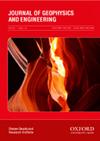Boundary recognition of tunnel lining void from ground penetrating radar data
IF 1.7
3区 地球科学
Q3 GEOCHEMISTRY & GEOPHYSICS
引用次数: 0
Abstract
Relatively low ground-penetrating radar antenna frequencies are usually selected for tunnel inspection due to the thickness of the lining, which causes the geometric features of voids in the image to be blurred and difficult to identify. Therefore, the boundary points of the voids are determined by combining reflection and attenuation coefficients, and the geometric features are constructed to identify the voids. Depending on the electromagnetic differences between the void and other mediums in the lining, when the electromagnetic wave propagates from the lining concrete to the void, the reflection coefficient is positive, and the phase of the reflected wave is the same as the incident wave. Conversely, the phase of the reflected wave is opposite to the incident wave. Therefore, the boundary point can be determined in the one dimension time-waveform diagram (A-Scan) based on the phase change. Moreover, the amplitude of the electromagnetic wave attenuates exponentially in the concrete, but it attenuates slowly in the void. And electromagnetic waves exhibit high-frequency characteristics in the lining but low-frequency characteristics in the voids. Boundary points that conform to the variation of amplitude and frequency characteristics in the void are screened. These boundary points are then constructed in two-dimensional scan data (B-Scan) to identify the voids by using the geometry of the voids. This method is applied to the Hu Sa tunnel. The voids are successfully identified in the mileage section YK81+310 - YK81+422 of the Hu Sa tunnel, and the depth of cover and the area of voids are correctly estimated.基于探地雷达数据的隧道衬砌空洞边界识别
由于衬砌的厚度,隧道检查通常选择相对较低的探地雷达天线频率,这导致图像中空洞的几何特征模糊且难以识别。因此,通过结合反射系数和衰减系数来确定孔隙的边界点,并构造几何特征来识别孔隙。根据衬砌中孔隙和其他介质之间的电磁差异,当电磁波从衬砌混凝土传播到孔隙时,反射系数为正,反射波的相位与入射波相同。相反,反射波的相位与入射波的相位相反。因此,可以基于相位变化在一维时间波形图(A-Scan)中确定边界点。此外,电磁波的振幅在混凝土中呈指数衰减,但在空隙中衰减缓慢。电磁波在衬砌中表现出高频特性,而在空隙中表现出低频特性。筛选符合空隙中振幅和频率特性变化的边界点。然后在二维扫描数据(B扫描)中构造这些边界点,以通过使用空隙的几何形状来识别空隙。该方法已应用于胡萨隧道。成功识别了胡萨隧道YK81+310~YK81+422里程段的孔隙,并正确估计了覆盖深度和孔隙面积。
本文章由计算机程序翻译,如有差异,请以英文原文为准。
求助全文
约1分钟内获得全文
求助全文
来源期刊

Journal of Geophysics and Engineering
工程技术-地球化学与地球物理
CiteScore
2.50
自引率
21.40%
发文量
87
审稿时长
4 months
期刊介绍:
Journal of Geophysics and Engineering aims to promote research and developments in geophysics and related areas of engineering. It has a predominantly applied science and engineering focus, but solicits and accepts high-quality contributions in all earth-physics disciplines, including geodynamics, natural and controlled-source seismology, oil, gas and mineral exploration, petrophysics and reservoir geophysics. The journal covers those aspects of engineering that are closely related to geophysics, or on the targets and problems that geophysics addresses. Typically, this is engineering focused on the subsurface, particularly petroleum engineering, rock mechanics, geophysical software engineering, drilling technology, remote sensing, instrumentation and sensor design.
 求助内容:
求助内容: 应助结果提醒方式:
应助结果提醒方式:


